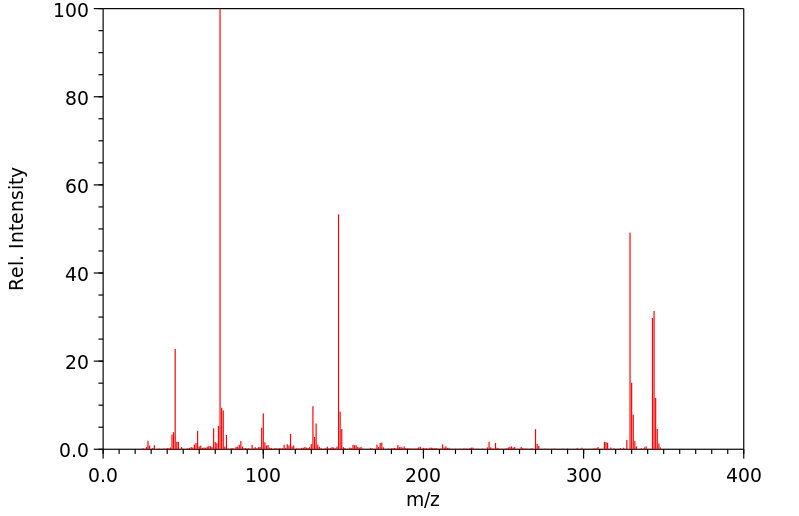2,4,6-tris(trimethylsilyloxy)pyrimidine | 31111-39-4
中文名称
——
中文别名
——
英文名称
2,4,6-tris(trimethylsilyloxy)pyrimidine
英文别名
2,4,6-tris(trimethylsiloxy)pyrimidine;Pyrimidine, 2,4,6-tris(trimethylsiloxy)-;[2,6-bis(trimethylsilyloxy)pyrimidin-4-yl]oxy-trimethylsilane
CAS
31111-39-4
化学式
C13H28N2O3Si3
mdl
——
分子量
344.633
InChiKey
MTDRSUCYKPIFHV-UHFFFAOYSA-N
BEILSTEIN
——
EINECS
——
-
物化性质
-
计算性质
-
ADMET
-
安全信息
-
SDS
-
制备方法与用途
-
上下游信息
-
文献信息
-
表征谱图
-
同类化合物
-
相关功能分类
-
相关结构分类
物化性质
-
沸点:144-145 °C(Press: 13 Torr)
-
密度:0.973±0.06 g/cm3(Predicted)
-
保留指数:1600;1592
计算性质
-
辛醇/水分配系数(LogP):4.12
-
重原子数:21
-
可旋转键数:6
-
环数:1.0
-
sp3杂化的碳原子比例:0.69
-
拓扑面积:53.5
-
氢给体数:0
-
氢受体数:5
SDS
反应信息
-
作为反应物:描述:氯甲基二甲基氯硅烷 、 2,4,6-tris(trimethylsilyloxy)pyrimidine 以 乙腈 为溶剂, 反应 3.0h, 以95%的产率得到6-[(chlorodimethylsilyl)methyl]-2,2-dimethyl-2H-[1,4,2]-oxazasilolo[4,5-c]pyrimidine-5,7(3H,6H)-dione参考文献:名称:尿嘧啶,巴比妥酸和5,5-二甲基巴比妥酸的双核硅配合物:环状低聚物的水解形成(1)†摘要:描述了通过与(氯甲基)二甲基氯硅烷和(氯甲基)二氯(甲基)硅烷反应,衍生自尿嘧啶,巴比妥酸和5,5-二甲基巴比妥酸的双核硅配合物的合成和性质。在所有三组化合物中,氧原子均与硅弱配位。双核化合物的轻度水解会导致形成环状低聚物,每个环状低聚物具有2-9个单体单元,其中各个单元通过硅氧烷基团连接。氯化锂被证明是有效的模板,将低聚限制为二聚体并防止形成更高质量的产物。DOI:10.1021/om100461b
-
作为产物:参考文献:名称:FOLKERS, GERD;JUNGINGER, GERLINDE;MULLER, CHRISTA E.;SCHLOZ, ULRICH;EGER,+, ARCH. PHARM., 322,(1988) N, C. 119-123摘要:DOI:
文献信息
-
Synthese computergraphik berechneter high-anti-fixierter Pyrimidin-Nucleosid-Analoga mit potentieller virostatischer und antineoplastischer Wirksamkeit作者:Gerd Folkers、Gerlinde Junginger、Christa E. Müller、Ulrich Schloz、Kurt EgerDOI:10.1002/ardp.19893220213日期:——substituierte 6,2′‐Anhydrouridine 5a–e dargestellt. Durch die aus der 6,2′‐Verknüpfung resultierende N1, C1‐Fixierung des Zuckerrestes an die Nucleobase in der high‐anti‐Konformation sollten Substanzen mit antiviralen und antineoplastischen Wirkungen zu erhalten sein. In Zellkulturtestsystemen waren die vermuteten Wirkungen jedoch bisher nicht nachweisbar.
-
Tuning Exciton Coupling of Merocyanine Nucleoside Dimers by RNA, DNA and GNA Double Helix Conformations作者:Julia Dietzsch、David Bialas、Johannes Bandorf、Frank Würthner、Claudia HöbartnerDOI:10.1002/anie.202116783日期:2022.2.21The barbituric acid merocyanine (BAM) is reported as a nucleobase surrogate that forms hydrogen-bonded base pairs, and antiparallel as well as rotationally stacked dimer aggregates, with orientation- and conformation-sensitive exciton coupling strength.
-
Azines and Azoles: CXX. Synthesis of Acyclic Analogs of N<sup>1</sup>-Ribosides of Barbituric Acid and Its 5-ylidene Derivatives作者:E. P. Studentsov、A. N. Kokhanovskii、M. B. Ganina、N. I. Nikolaeva、E. V. Fedorova、A. V. Moskvin、B. A. IvinDOI:10.1023/b:rugc.0000025513.88248.94日期:2004.2The reaction of 2,4,6-tris(trimethylsiloxy)pyrimidine with 2-oxabutane-1,4-diyl diacetate in methylene chloride in methylene chloride in the presence of SnCl4 proceeds regioselectively to form 1-[(2-acetoxyethoxy)methyl]barbituric acid. The latter is readily deacetylated to a free acyclic analog of N-ribosides of barbituric acid. 1[(2-Acetoxy- and 2-hydroxyethoxy)methyl]barbituric acids easily react with aromatic and heterocyclic aldehydes in water and organic solvents, forming 5-ylidenebarbituric acids. The structure of the products was proved by H-1 NMR and UV spectroscopy. Certain of the products exhibit a moderate antimicrobial and antiviral activity.
-
Synthesis and Structure−Activity Relationships of Uracil Nucleotide Derivatives and Analogues as Agonists at Human P2Y<sub>2</sub>, P2Y<sub>4</sub>, and P2Y<sub>6</sub> Receptors作者:Ali El-Tayeb、Aidong Qi、Christa E. MüllerDOI:10.1021/jm060848j日期:2006.11.30A series of UTP, UDP, and UMP derivatives and analogues were synthesized and evaluated at the human pyrimidinergic P2Y receptor subtypes P2Y(2), P2Y(4), and P2Y(6) stably expressed in 1321N1 astrocytoma cells. Substituents at N3 of UTP were poorly tolerated by P2Y2 and P2Y4 receptors. In contrast, a large phenacyl substituent at N3 of UDP was well tolerated by the P2Y6 receptor, yielding a potent and selective P2Y6 receptor agonist (3-phenacyl-UDP, EC50 = 70 nM, > 500-fold selective). The most potent and selective P2Y2 receptor agonist of the present series was 2-thio-UTP (EC50 = 50 nM, >= 30-fold selective vs P2Y(4) and P2Y6). All modifications at the uracil base of UTP led to a decrease in potency at the P2Y4 receptor. A beta,gamma-dichloromethylene modification in the triphosphate chain of 5-bromo-UTP was tolerated by all three receptor subtypes, thus opening up a new strategy to obtain ectonucleotide diphosphohydrolase- and phosphatase-resistant P2Y(2), P2Y(4), and P2Y(6) receptor agonists.
-
Tzeng, Cherng-Chyi; Panzica, Raymond P.; Naguib, Fardos N.M., Journal of Heterocyclic Chemistry, 1993, vol. 30, # 5, p. 1399 - 1404作者:Tzeng, Cherng-Chyi、Panzica, Raymond P.、Naguib, Fardos N.M.、Kouni, Mahmoud H. elDOI:——日期:——
表征谱图
-
氢谱1HNMR
-
质谱MS
-
碳谱13CNMR
-
红外IR
-
拉曼Raman
-
峰位数据
-
峰位匹配
-
表征信息
同类化合物
(S)-3-(2-(二氟甲基)吡啶-4-基)-7-氟-3-(3-(嘧啶-5-基)苯基)-3H-异吲哚-1-胺
(6-羟基嘧啶-4-基)乙酸
(4,5-二甲氧基-1,2,3,6-四氢哒嗪)
鲁匹替丁
马西替坦杂质7
马西替坦杂质4
马西替坦杂质
马西替坦原料药杂质D
马西替坦原料药杂质B
马西替坦
顺式-4-{[5-溴-2-(2,5-二甲基-1H-吡咯-1-基)-6-甲基嘧啶-4-基]氨基}环己醇
非沙比妥
非巴氨酯
非尼啶醇
青鲜素钾盐
雷特格韦钾盐
雷特格韦相关化合物E(USP)
雷特格韦杂质8
雷特格韦EP杂质H
雷特格韦-RT9
雷特格韦
阿西莫司杂质3
阿西莫司
阿脲四水合物
阿脲一水合物
阿维霉素
阿米美啶
阿米洛利
阿米妥钠
阿洛巴比妥
阿普瑞西他滨
阿普比妥
阿巴卡韦相关化合物B(USP)
阿卡明
阿伐那非杂质V
阿伐那非杂质1
阿伐那非杂质
阿伐那非中间体
阿伐那非
铂(2+)二氯化6-甲基-1,3-二{2-[(2-甲基丙基)硫烷基]乙基}嘧啶-2,4(1H,3H)-二酮(1:1)
钴1,2,3,6-四氢-2,6-二氧代嘧啶-4-羧酸酯(1:2)
钠5-烯丙基-4,6-二氧代-1,4,5,6-四氢-2-嘧啶醇酸酯
钠5-乙基-4,6-二氧代-1,4,5,6-四氢-2-嘧啶醇酸酯
钠5-(2-溴丙-2-烯基)-5-丁烷-2-基-4,6-二氧代-1H-嘧啶-2-醇
醌肟腙
酒石酸噻吩嘧啶
那可比妥
辛基2,6-二氧代-1,2,3,6-四氢-4-嘧啶羧酸酯
赛乐西帕杂质3
赛乐西帕KSM3







